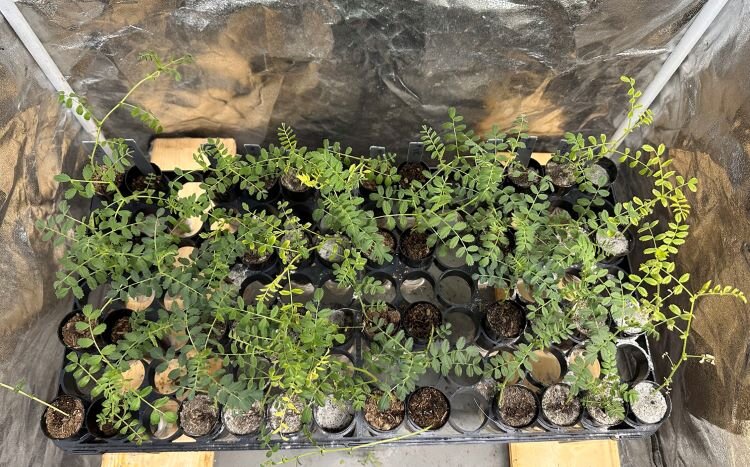A recent preprint posted to bioRxiv investigates how chickpeas have been successfully grown in lunar regolith simulants (LRS), marking the first time such a guideline has been established not only for chickpeas, but also for growing food for long-term human space missions.
This study was conducted by researchers from Texas A&M University and Brown University and holds the potential to develop more efficient methods in growing foods using extraterrestrial resources, specifically with NASA’s Artemis program slated to return humans to the lunar surface in the next few years.
“The moon doesn’t have soil like Earth does,” said Jessica Atkin, who is a M.S. student in Soil Science at Texas A&M University and lead author of the study. “On Earth, the soil has organic material filled with nutrients and microorganisms, which support plant growth. Those are missing on the moon. This adds to other challenges, such as reduced gravity, radiation, and toxic elements.”
For the study, the researchers compared the relationship between Vermicompost (VC) and Arbuscular Mycorrhizal Fungi (AMF) with the goal of creating a productive LRS structure for successfully growing chickpeas (Cicer arietinum). AMF is often used to aid in plant growth hormone production while VC contains worm manure that is used to enhance seed growth. The team analyzed various combinations of 25%, 50%, 75%, and 100% LRS, with each being mixed with corresponding measurements of VC and AMF. While the experiments were scheduled to run for 120 days, the researchers discovered 100% seed growth by day 16, and continued to grow throughout week 6, 9, and 11, as well.
The study notes, “We report the first instance of growing chickpea (Cicer arietinum) in lunar regolith simulants. We used soil regeneration techniques common on Earth with LRS for the first time, using both AMF and VC. We also achieved the first documented chickpea yield in an LRS mixture. Our results show that regeneration methods used on Earth soils can help condition lunar regoliths. Despite promising results, all plants in LRS showed signs of chlorophyll deficiency.”
Chlorophyll has the vital responsibility for absorbing light, most often sunlight, for the plant to use for photosynthesis. While the team did note chlorophyll deficiencies, they also noted, “By week seven, a visible improvement in chlorophyll levels suggests successful AMF colonization in the inoculated group” with the inoculation occurring due to the incorporated AMF.
As noted, this study comes as NASA is planning on sending humans back to the moon with its Artemis program in the next few years. Successfully growing plants using lunar regolith is also known as in situ resource utilization (ISRU), which could significantly reduce the need for constant resupply of food or soil from Earth. While not directly mentioned in the study or by the researchers, this study mirrors NASA’s Lunar Surface Innovative Initiative whose goal is to develop technologies on the moon that could be used for future crewed missions to Mars.
“The novelty about using vermiculture is that it can all be done in space, whether in a space station or on the moon, reducing the need for resupply missions,” said Atkin.
This novelty not only includes the International Space Station (ISS) and upcoming Artemis missions but could also include commercial space stations such as the planned Axiom Station, which is due to send its first module to the ISS sometime in 2026. To exemplify the progress that’s been made toward growing plants in LRS, this study comes after researchers at the University of Florida successfully grew the plant, Arabidopsis thaliana, in lunar regolith while discovering the plants did not achieve desired parameters, which this most recent study has achieved.
More information:
Jessica A. Atkin et al, From dust to seed: a lunar chickpea story, bioRxiv (2024). DOI: 10.1101/2024.01.18.576311
Citation:
Chickpeas grown in lunar regolith are stressed but reach maturity, shows study (2024, February 8)
retrieved 8 February 2024
from https://phys.org/news/2024-02-chickpeas-grown-lunar-regolith-stressed.html
This document is subject to copyright. Apart from any fair dealing for the purpose of private study or research, no
part may be reproduced without the written permission. The content is provided for information purposes only.


